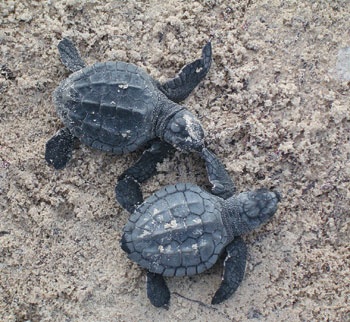Just before the early summer sun peeks over the Gulf of Mexico, several members of the Padre Island National Seashore staff carry a standard-issue grocery store cooler to the beach. Inside are Kemp’s ridley sea turtle hatchlings. At 11/2 to 2 inches long, the turtles are smaller than the palm of one of the gloved hands that scoop them up and carefully place them on the shore a few feet from the surf. The hatchlings immediately scurry over sand and seaweed toward the water, which at first sweeps them back up the shore. With flippers churning like tiny propellers, the turtles try again and again, finally catching a wave that carries them out to sea.
During the summer of 2007, this scene was repeated 128 times on the Texas coast. Following their release, the hatchlings swim for several days, then drift with currents to floating masses of sargassum seaweed or debris, which provide cover from predators and plenty to eat until the turtles grow large enough to navigate the open sea. In the wild, perhaps only 1 in 1,000 turtle eggs survives to adulthood. Shepherding the hatchlings safely to the water after first incubating the eggs in a specially designed lab at the seashore improves those rather dismal odds. Similar efforts protect eggs and hatchlings in Mexico.
In 1978, when the worldwide count for Kemp’s ridleys was barely 900 (not a single one of them in Texas), scientists founded the multiagency, binational Kemp’s Ridley Sea Turtle Restoration and Enhancement Project. For the next 10 years, the project collected several thousand eggs annually from the turtle’s only known nesting site, a beach in northern Mexico. Those eggs were incubated in sand from North Padre Island, where the species had nested decades earlier, and the hatchlings were released on island beaches.
The idea, says Donna Shaver, chief of the Division of Sea Turtle Science and Recovery at Padre Island National Seashore, was to imprint the turtles on the location and establish a second nesting area so the species would not literally have all its eggs on one beach. It was a long wait, but sure enough, in 1996, turtles finally returned to Padre Island to lay eggs, and the number of nests has increased each year. Today, the National Seashore is the most important Kemp’s ridley nesting area in the United States.
The drastic decline in the number of Kemp’s ridleys prior to 1978 was primarily due to two things, according to Shaver: large-scale human taking of eggs from the nesting beach in Mexico, where they are considered a delicacy, and loss of juvenile and adult turtles in fishing operations. Protecting nests in both countries and reducing the take of adults from commercial and recreational fishing through information campaigns and devices that allow turtles to escape nets have contributed to the encouraging rise in nesting turtles. But the species is still far from recovery, which is currently defined as 10,000 nests worldwide in a single season.
Drowning in shrimp nets remains the main cause of Kemp’s ridley mortality, while harvesting of eggs, slaughter for food and incidental capture by fishing operations continue. Propeller strikes, entanglement in and ingestion of marine debris, and dredging are also major threats, Shaver says.
“The current prognosis for Kemp’s ridley is encouraging. But it remains the most critically endangered sea turtle species,” stresses Patrick Burchfield, director of Brownsville’s Gladys Porter Zoo, one of the 30 organizations and businesses on both sides of the border involved in the recovery project. “We cannot relent until we have reached our objective for removing them from the endangered list. We must have the necessary safeguards and strategies in place both in the U.S. and Mexico so history does not repeat itself.”
Scientists emphasize that the public is an important part of the turtle’s recovery. Kemp’s ridleys usually come ashore to nest during the day, when wind is likely to blow away a nesting mother’s telltale tracks in the sand. Reaching 80 to 100 pounds and 2 feet in shell length, Kemp’s ridleys are the smallest and lightest sea turtles. The largest, leatherbacks, reach 4 to 6 feet in length and are 1,000 pounds-plus. When the relatively light Kemp’s ridleys come ashore to nest, they leave only faint tracks on the beach in the best of conditions. They take just 45 minutes to crawl onto the sand, bury their eggs, and return to the water. Park staff and trained volunteers monitor 80 miles of Texas beach from March through July, but beachgoers still find the majority of turtles.
Shaver also recently trained her cairn terrier, appropriately named Ridley, to sniff out turtle eggs. Last summer, beach patrollers spotted turtle tracks, and staff and volunteers searched for her nest in the deep, wind-blown sand of North Padre Island for five hours before calling in Ridley. He immediately found the nest, and the team took the eggs to safety in the lab.
People should report nesting turtles immediately, Shaver says. The public can also help protect the turtles in other ways, including driving slowly and carefully on all beaches, limiting beach lighting (which confuses hatchlings), and not intentionally harming or taking turtles (it is illegal to take home a hatchling, a nesting turtle or eggs).
“Don’t litter or throw trash in the water, especially plastic, since turtles can ingest it, and it has been linked to turtle death,” she adds. “Pick up plastic bags. Recycle. If you’re boating in an area where you see turtles, slow down and avoid collision with them. If you see turtles in the water and are fishing, try to move elsewhere so you don’t unintentionally catch one or snag one in the flipper.”
In addition to Kemp’s ridleys, four more of the world’s seven species of sea turtles are found in the Gulf of Mexico: leatherback, hawksbill, green and loggerhead turtles. All five species nest on the National Seashore now or have in the past, and all are threatened or endangered. Since the recovery project began, the worldwide high for Kemp’s ridley nests in a year has risen to 5,000. While only half the number needed to change the species’ endangered status, the trend is definitely positive.
“It’s a compelling story,” says Shaver, who since 1980 has dedicated her career to helping the turtles. “Humans caused the decline, and now humans are part of the success.”
——————–
Melissa Gaskill has written about state parks for Texas Co-op Power.


